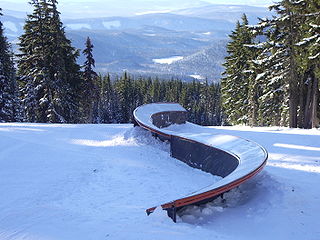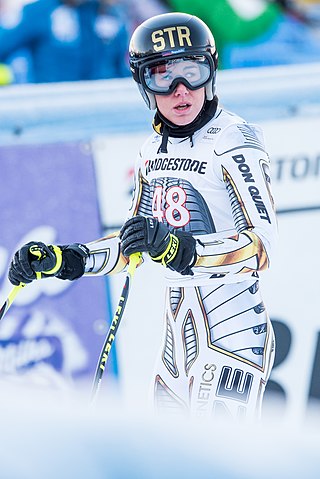
Slalom is an alpine skiing and alpine snowboarding discipline, involving skiing between poles or gates. These are spaced more closely than those in giant slalom, super giant slalom and downhill, necessitating quicker and shorter turns. Internationally, the sport is contested at the FIS Alpine World Ski Championships, and at the Olympic Winter Games.

Skiing is the use of skis to glide on snow. Variations of purpose include basic transport, a recreational activity, or a competitive winter sport. Many types of competitive skiing events are recognized by the International Olympic Committee (IOC), and the International Ski Federation (FIS).

The FIS Alpine Ski World Cup is the top international circuit of alpine skiing competitions, launched in 1966 by a group of ski racing friends and experts which included French journalist Serge Lang and the alpine ski team directors from France and the USA. It was soon backed by International Ski Federation president Marc Hodler during the FIS Alpine World Ski Championships 1966 at Portillo, Chile, and became an official FIS event in the spring of 1967 after the FIS Congress at Beirut, Lebanon.

Downhill is a form of alpine skiing competition. Whereas the other alpine skiing events emphasize turning and technique, downhill emphasizes "the six components of technique, courage, speed, risk, physical condition and judgement", according to the FIS "International Ski Competition Rules (ICR)". Speeds of up to 130 km/h (81 mph) are common in international competition. Athletes must have an aerodynamically efficient tuck position to minimize drag and increase speed.

Giant slalom (GS) is an alpine skiing and alpine snowboarding competitive discipline. It involves racing between sets of poles ("gates") spaced at a greater distance from each other than in slalom but less than in Super-G.

Super giant slalom, or super-G, is a racing discipline of alpine skiing. Along with the faster downhill, it is regarded as a "speed" event, in contrast to the technical events giant slalom and slalom. It debuted as an official World Cup event during the 1983 season and was added to the official schedule of the World Championships in 1987 and the Winter Olympics in 1988.

Ski cross is a skiing competition which incorporates terrain features traditionally found in freestyle skiing with courses which include big-air jumps and high-banked turns. In spite of the fact that it is a timed racing event, it is often considered a type of freestyle skiing. What sets ski cross apart from other alpine skiing disciplines is that it involves more than one skier racing down the course. Any intentional contact with other competitors like grabbing or any other forms of contact meant to give the competitor an advantage leads to disqualification.
Combined is an event in alpine ski racing. The event format has changed within the last 30 years. A traditional combined competition is a two-day event consisting of one run of downhill and two runs of slalom; each discipline takes place on a separate day. The winner is the skier with the fastest aggregate time. Until the 1990s, a complicated point system was used to determine placings in the combined event. Since then, a modified version, called either a "super combined" or an "Alpine combined", has been run as an aggregate time event consisting of two runs: first, a one-run speed event and then only one run of slalom, with both portions held on the same day.

The following outline is provided as an overview of and topical guide to skiing:

Carlo Janka is a Swiss former alpine ski racer. Born in Obersaxen, in the canton of Graubünden, he had the winter sports facilities right in front of his home. Janka has won gold medals at both the Winter Olympics and the World Championships, as well as one World Cup overall title, one discipline title and also, one unofficial alpine combined title.
The FIS Snowboarding World Championships is the world championship organized by the FIS for Snowboarding. It was first held in 1996 and is now held every odd year. The championship events include Big air, Halfpipe, Parallel giant slalom, Parallel slalom, Slopestyle and Snowboard cross for both genders as well as mixed team events in Parallel slalom and Snowboard cross.

Kjetil Jansrud is a Norwegian former World Cup alpine ski racer and Olympic champion. He competed in all alpine disciplines apart from slalom, and his best event was the giant slalom where he has six World Cup podiums and an Olympic silver medal. Since 2012, he had concentrated on the speed events, where all but two of his World Cup victories had come. At the 2014 Winter Olympics in Sochi, he won the super-G and placed third in the downhill. At the World Championships in 2019 at Åre, Jansrud won gold in the downhill.

Snowboard cross, also known as boardercross, is a snowboard competition in which four to six competitors race down a course. Snowboard cross courses are typically quite narrow and include cambered turns, various types of jumps, berms, rollers, drops, steep and flat sections designed to challenge the riders' ability to stay in control while maintaining maximum speed. It is not uncommon for racers to collide with each other mid-race.

Benjamin Griffin, also known as Ben Griffin, is an alpine skier from New Zealand. He competed for New Zealand at the 2010 Winter Olympics in Giant Slalom and Super G where he failed to finish the first run of either event.

Ester Ledecká is a Czech snowboarder and alpine skier. At the 2018 Winter Olympics in Pyeongchang, Ledecká won gold medals in the super-G in alpine skiing and in the parallel giant slalom in snowboarding, becoming the first person to not only compete in the Winter Olympics using two different types of equipment but further to win two gold medals and do so at the same Winter Olympics. She was the second woman to win Olympic gold in two separate disciplines but the first to do so at the same Winter Olympics. She was the first Czech to win the parallel giant slalom in snowboarding at the FIS Snowboard World Cup.

Ina Meschik is an Austrian alpine snowboarder. She represented her nation Austria in two editions of the Olympic Games, and eventually claimed a bronze medal in parallel giant slalom at the 2010 FIS Junior World Championships in Lake Wanaka, New Zealand and fourth-place finishes at the FIS World Cup series. Meschik is currently a member of ASKÖ Landskron Ski Club in Villach, under her personal coach Tom Weninger.
Julie Pomagalski was a French snowboarder.

The International Ski Federation (FIS) Alpine Ski World Cup, the premier circuit for alpine skiing competition, began in January 1967, and the 2019–20 season marked the 54th consecutive year for the FIS World Cup. As it had every year since 2006, the season began in Sölden, Austria in October. The season was supposed to end with the World Cup finals in March, which were to be held in Cortina d'Ampezzo, Italy for the first time since they began in 1993, but the finals were cancelled due to the COVID-19 outbreak in Italy.
Mike Jacoby is an American snowboarder who competed in the 1998 Nagano Winter Olympics.

The Men's Parallel in the 2020 FIS Alpine Skiing World Cup was contested as a World Cup discipline separate from slalom for the first time in 2020. Prior to the season, FIS decided to combine parallel skiing events into a new discipline, joining the existing disciplines of downhill, Super-G, giant slalom, slalom, and combined. The discipline winner would receive a small crystal globe, similar to the other disciplines. However, at the same time, FIS decided to drop the city events to reduce the amount of travel required during the World Cup season, planning to replace them with more parallel events at regular venues.















